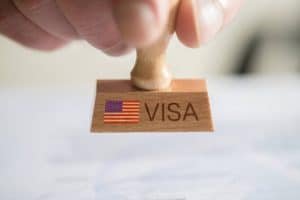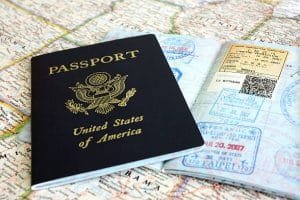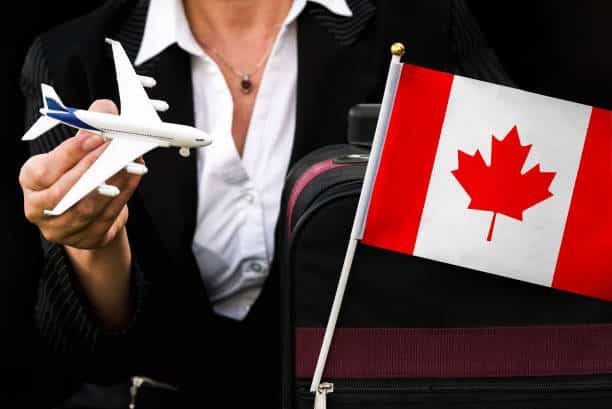Best Guide On How To Apply For USA Employment Visa Sponsorship

Have you been on the lookout for a guide that discusses how to apply for a USA employment visa sponsorship? Lucky you, this article is one.
The US is one of the countries with a high economic development and a powerful global force. People worldwide are drawn to America by its promise of success and the American dream. They want to settle in the nation, work and start new lives. But even though there is a great demand for jobs in the US, the application process can be drawn out. To work legally in the nation, foreigners must go through a number of steps.
A US work sponsorship is a crucial first step. The specifics and knowledge surrounding US employment visa sponsorship will be examined in this article.
The most typical visa kinds will be known to everyone who has visited the US. You will have applied for a visa or traveled under the Visa Waiver Program if you have visited friends or family, traveled for business, or spent time on vacation in the US.
A visa is a travel document that a nation issues to a visitor, allowing them entry and temporary residence for a particular purpose, such as tourism, journalism, study, or employment. When it comes to working visas, things become more challenging. These visas enable visitors to work for a US employer while they are in the nation, usually temporarily but occasionally permanently. There are many different kinds of work visas, and the majority of them demand that you have employer sponsorship and a job offer before you enter the country.
Obtaining a work visa in the United States is complicated and requires legal expertise. Our basic guide covers the most important points you should be aware of before beginning the process. However, keep in mind that the information in this guide is intended to be general in nature and does not constitute legal advice. All of the most recent official guidance and additional information can be found at travel.state.gov.
What is a work visa?
Work visas make up a sizable portion of the nearly 200 different types of visas available in the United States. In general, they allow a foreign national to enter and work in the United States permanently or for a limited time. They could be a printed document, a passport stamp or sticker, or an electronic record. A work visa differs from a work permit, which is a legal document that authorizes an individual who is already in the United States to work without restriction. A work permit does not grant permission to enter the United States, whereas a work visa does.

How do I obtain sponsorship for a work visa in the United States?
You must have a job offer from a specific US employer before you can even apply for a US work visa. The employer will then petition the US Citizenship and Immigration Services to sponsor your visa (USCIS). This type of work visa falls under the umbrella of petition-based visas.
If your petition is granted, you will be able to apply for a work visa at a US consulate or embassy in your home country. Work visa requirements vary depending on the type of visa you’re applying for, but most work visa applicants must meet the following general requirements:
- A work offer from a US company is required.
- Your position must fall under one of the categories listed under “Occupations Eligible for Work Visas.”
- You must possess the necessary training or work experience for the position.
- After your work visa expires, you must demonstrate that you’ll return to your home country.
Types of US nonimmigrant work visas that need employment sponsorship
Nonimmigrant work visas are intended for visitors who plan to work in the US only briefly before departing for their home countries.
A nonimmigrant work visa can last for many years, in contrast to the straightforward, 90-day B-1 business visa, which allows business travelers to enter the country for things like contract negotiations, meetings, conferences, and conventions. They typically need to be sponsored by a US employer, and if the worker wants to keep working in the US, they must be renewed.
An overview of some of the most common nonimmigrant and petition-based work visa categories is provided below. You can locate a comprehensive list at travel.state.gov.
H-1B Speciality Occupation visa
The H-1B work visa is the most widely used category in the US. Employers may use this visa to hire highly qualified foreign workers in specialized industries like engineering, architecture, science, and information technology. Each year, there is a cap on the number of applicants, and candidates must have a bachelor’s degree (or its equivalent) in the field of their choice.
A typical H-1B visa allows for three years of employment in the US, with a possible six-year extension. Workers are not required to remain with the employer who initially sponsored them, so they are free to change jobs as soon as they arrive in the US, provided that the new employer is able to sponsor an additional H-1B visa.
The Specialty Occupation visa, also known as the H1B visa, is a nonimmigrant work permit for graduate-level workers to engage in a role with a US employer in a specialty occupation requiring theoretical or technical expertise.
You must have a bachelor’s degree or higher, or the equivalent, in the specialty occupation for which sponsorship is being sought in order to qualify for an H1B visa. However, there is no legal definition of what a specialty occupation is. USCIS will decide whether the position is acceptable and whether you, the prospective employee, are qualified to fill the position.
You might be able to demonstrate degree equivalence in cases where you don’t have a bachelor’s or higher degree through your work experience or other qualifications. Additionally, you must be able to show that your area of study or professional background makes you uniquely qualified for the job in question.
Your potential employer must submit an employment-based petition to USCIS as well as a labor condition application with the Department of Labor before they can apply for an H1B visa.
L-1 Intra-Company Transfer visa
This visa, also known as an intra-company transfer visa, allows an employee to be temporarily transferred to a US branch or subsidiary of their present firm. The employee must have worked for the company abroad for at least a year and be an executive or manager with specialized knowledge. Companies that are opening a satellite office as part of their expansion into the US frequently employ an L-1 visa.
The Intra-Company Transfer visa enables you to temporarily transfer to a parent, branch, affiliate, or subsidiary of the same company in the USA to take up employment in the same or similar roles if you are already employed by a foreign employer with a connected US office.
Employees who are being sent to the United States to create a new office can also use the L1 visa, also known as the intra-company transfer visa.
However, regardless of the situation, your US employer must submit a petition on your behalf to USCIS before you can apply for your L1 visa unless the business regularly transfers a large number of employees and, as a result, already has a blanket petition in place.
You must hold a managerial or executive level position in your organization (L1A visa) or possess some level of specialized knowledge about the products, processes, or management within your organization (L1B visa) and be destined for a position in the United States at a level equivalent to your current one. Additionally, you must have worked for the company for a full year within three years prior to applying for your visa.
O-1 Extraordinary Ability visa
The Extraordinary Ability or Extraordinary Achievement visa, also known as the O1 visa, should be considered if you meet the criteria for “exceptional talent” or can provide evidence of a record of extraordinary achievement in your professional field.
The O1B visa is for people who have achieved extraordinary success in the film or television industries as well as for those with extraordinary ability in the arts, while the O1A visa is for people who have exceptional ability in the sciences, education, business, or athletics.
You must exhibit extraordinary ability through ongoing national or international acclaim in order to be granted an O1 visa, and you must be moving to the US to continue working in this field. Achieving a level of competence that suggests you are among the select few who have attained the pinnacle of your profession on a worldwide scale is what is meant by extraordinary talent.
You must have a level of skill and recognition that is significantly above what is typically encountered in order to be recognized as outstanding, notable, or at the forefront of the television and/or motion picture industries.
Again, just like with the L1 and H1B visas, you will need a US sponsor to petition USCIS on your behalf before you can apply for an O1 visa.

Types of US immigrant work visas that need employment sponsorship
People who wish to permanently live and work in the US are eligible for immigrant work visas. Almost always, these work visas are issued prior to the person receiving their green card, which designates them as Lawful Permanent Residents of the United States.
Moving to the US on an immigrant visa based on a job is a difficult and drawn-out procedure. Candidates must have a work offer in order to be qualified, and then their US employer must complete a stringent set of sponsorship procedures before the application process can even start.
Priority employees are given the highest precedence when applying for immigrant work visas, which are categorized into five categories:
- First: Priority workers
- Second: Professionals holding advanced degrees and persons of exceptional ability
- Third: Professionals and other workers
- Fourth: Certain special immigrants
- Fifth: Employment creation/investors
Most of the visas in the group need employment sponsorship.
- EB-1 Visa – Outstanding academics, researchers, and individuals with prodigious talent in the humanities, sciences, business, sports, or education. Additionally, top managers have spent the previous three years working for a US company’s overseas unit.
- EB-2 Visa –advanced degree holders and individuals with exceptional talent in the arts, sciences, or business.
- EB-3 Visa – professionals with a higher education degree and skilled workers with more than two years of experience. Additionally, unskilled individuals with under two years experience (EW-3 Visa).
- EB-4 Visa – Workers for various governmental, religious, or international organizations.
- Self-petitioning is permitted for certain of these visas, including the EB-1 visa. In some circumstances, if you possess such outstanding qualities, you may be able to sponsor your own visa. You are responsible for all payments and document submissions. Other visas, like the EB-5 visa, can only be obtained by filing a self-petition.
How much does sponsoring a US work visa cost?
The cost of obtaining a US work visa varies according to the type of work visa requested, the size of the company, and the number of current employees who are already present in the US on a work visa. The majority of these costs will be covered by the sponsoring employer, but the employee might also be responsible for some of them.
The most common fees for nonimmigrant work visa sponsorship are:
- Petition fee: $460
- Application fee: $190
- American Competitiveness and Workforce Improvement Act charges: $750 to $1,500
- Fraud Prevention and Detection fee: $500
- Added fee for companies with more than 50 employees, where half are foreign nationals: $4,000
The full list of US work visa filing fees can be found on the official USCIS website.
What is a US Visa Sponsorship?
You need to acquire employment before you may travel to the US to work. The employer must be open to taking on a non-US citizen. You must disclose to the employer that you are not an American citizen or Legal Permanent Resident (LPR). The employer agrees to sponsor you if they are aware of this and still want to recruit you.
A US visa or employment sponsorship indicates that you are being hired by a US company. They are promising that you will be a legitimate worker residence to the US visa authorities. According to the employer, you will perform the duties of the position for which you were hired. Additionally, they must ensure that you will be paid the same as a US citizen or lawful permanent resident in the same employment.
Contrary to what most people believe, an employer visa sponsorship is not just a letter. They consist of a collection of documents that are forwarded to US Citizenship and Immigration Services (USCIS). Unlike what most people believe, there are multiple sponsorship letters. Different forms and letters with employment information must be included in the documents. Additionally, they must mention that the employer is willingly recruiting the worker.
Justifying the hiring of a foreign employee is difficult when sponsoring a visa for work. Why not employ a US citizen or LPR since the country has a sizable population? When attempting to sponsor a foreign employee, this is one question that the majority of firms must respond to.
The employer needs to post job ads and submit other paperwork to the US Department of Labor to resolve this. The hiring manager must wait for a response to the job postings. They can claim that they were unable to locate somebody to undertake the job if no one steps forward. This will imply that US citizens or LPRs were not qualified for that post or available to fill it. The US employer can then defend hiring a foreign worker.
To sum up, you must locate a company willing to sponsor you if you wish to work in the US. Working without sponsorship entails engaging in illicit employment. You might be arrested or subject to deportation as a result.
SEE ALSO: All You Need To Know About Texas Veteran Grants
How Can I Obtain a Sponsor Letter for a US Visa?
As previously stated, in order to obtain a sponsorship employment visa, you must have an offer from a US employer. The US employer must send you a contract to sign, which will be included in the sponsorship paperwork.
The Department of Labor requires a Labor Certification for some nonimmigrant visas. This is the section in which the US employer demonstrates that they could not find a suitable US employee and must hire a foreigner.
The employer submits the petition after receiving this certification. The petition includes all supporting documents, contracts, itineraries, and the employee’s qualifications. It is then forwarded to USCIS. The employer must file Form I-129, Petition for Nonimmigrant Worker, in order to sponsor a nonimmigrant worker. Form I-140, Immigrant Petition for Alien Worker, is submitted by the employer for immigrant visas.
These petitions and instructions are available on the USCIS website. If the employer wishes to complete them, they may do so in accordance with the instructions. Many employers, however, hire a lawyer to complete them because mistakes are common. Mistakes in filing or submission can cause visa processing to be delayed.
The case is processed once USCIS receives the petition and supporting documents. Because there are so many petitions, the wait time can be considerable. Some employees wait months, if not years, to hear back from USCIS.
When the USCIS makes a decision, it notifies both the employer and the employee. If they deny the petition, the notice explains why. It could be because the employee was insufficiently qualified or there was insufficient documentation.
If the petition is approved by USCIS, the notice will be positive. It will then specify the next steps that both the employer and the employee must take in order to obtain the actual visa. Then, depending on the type of visa desired, the application process begins. The application is then processed at the US Embassy in the employee’s home country.
E Treaty Trader & Treaty Investor visas
If sponsorship is not for you, you have other choices to consider, such as moving to the United States to make an investment or starting your own business. However, as a businessperson, you will either need to have established trading relations with the US or substantial funding to invest in a US company.
The E1 and E2 visas, also known as the Treaty Trader and Treaty Investor visas, are nonimmigrant work visas available to nationals of nations with which the US has a treaty of commerce and navigation.
To qualify for an E1 Treaty Trader visa, you must be traveling to the US to expand an already-existing trading relationship between the US and your treaty countries by engaging in significant commerce in goods, money, or services.
Your whole international trade should be primarily with the United States or more than 50% of it. There is no set need for the volume of trade that must occur, though typically, the volume of transactions will be prioritized over total dollar value.
You may also be eligible for an E1 visa if you are a senior employee in an executive or managerial role or if you have the abilities required for the company to operate in the United States.
In order to qualify for an E2 Treaty Investor visa, you must be traveling to the US to work as an executive, supervisor, or other kinds of skilled worker for a legitimate business in which you have invested, or are planning to invest, a significant amount of capital.
Despite the fact that the investment amount is not explicitly stated in the law, as a general rule, you must contribute at least US$100,000.
Starting work in the US
You must submit a visa application to the nearest US Embassy or Consulate in your country of residency after obtaining US sponsorship and, if necessary, having your petition accepted by USCIS. Additionally, you will have to set up an interview at this time and pay a non-refundable application fee.
You will be permitted to travel to the US to carry out the work for which authorization was requested if your application for a US work visa is approved after your interview.
However, receiving a visa does not always ensure entrance. A visa is just proof that a consular official has found you eligible to request entry into the USA for that particular reason. Your eligibility for entry into the nation will still be left up to the discretion of immigration officers at the port of entry.
You will be allowed to stay in the USA for a set amount of time after being admitted into the country on a nonimmigrant visa, excluding instances in which you violate the terms of your visa.
Depending on the specifics of your visa category, you could even be able to apply for a green card, which would allow you to permanently live and work in the United States.
FAQS
What is the cost of the sponsored visa?
Sponsorship for an employment visa is not inexpensive. Particularly to the US employer, who must cover the majority of the costs. Sponsoring a foreign worker could cost up to a few thousand dollars, depending on the type of visa. Employers are apprehensive about doing it since it is so pricey.
The actual fees vary depending on the type of visa, however, the following is a basic breakdown of the most frequent fees and their costs:
- Form I-129 – $460
- Form I-140 – $700
- American Competitiveness and Workforce Improvement Act of 1998(ACWIA) – $750 or $1,500
- Fraud Prevention and Detection Fee – $500
- For employers with 50 or more employees and 50% of them are foreign – $4,000 or $4,500
Is a Visa Sponsorship Letter Required?
Because there are so many different types of US visas, it can be difficult to determine which ones are for employment. Even within the United States, for very short-term seasonal work, you may not require sponsorship. However, keep in mind that most job opportunities in the United States will necessitate a visa sponsorship.
What exactly is a sponsorship letter?
A sponsorship letter is a document issued by a US employer outlining the terms of your job offer and sponsorship arrangement. It is an essential part of the work visa application process, and it is one of the first things the USCIS will request when they receive your petition.
How many years is the USA Sponsor visa valid?
Obtaining a visa and a sponsor are challenging processes. You can plan your trip once you have received your visa. You can begin working as soon as you get to the US. However, the validity of a nonimmigrant work visa is only transitory. This implies that it will expire eventually.
Depending on the type of visa you have, the nonimmigrant work visa’s validity period may vary. Some, like the H-1B visa, are only good for a year at a time, while others may be three years long. To avoid overstaying, you must verify the details of your visa.
Some people are eligible for extensions when their visas are about to expire. Your employer may reapply to USCIS for sponsorship, and you may then be granted a visa. However, there are only a few extensions available for nonimmigrant visas. You won’t typically be able to extend for more than two or three times.
The immigrant work visas are also perpetual. After receiving these visas, you are granted a Green Card. The Green Card is renewable indefinitely and has a 10-year validity period. You can also apply for US citizenship after living and working in the country for five years.
Conclusion On USA Employment Visa Sponsorship
According to US immigration law, there are numerous distinct categories of work visas that permit foreign nationals to engage in temporary employment in the US. Above, we have examined the definition of a “temporary work visa USA” as well as some of the existing possibilities. The types of visas that you might find useful are described in the post; please enjoy them as you read.
READ ALSO: Care Assistant Jobs in UK 2023 – With Tier 2 Visa Sponsorship





